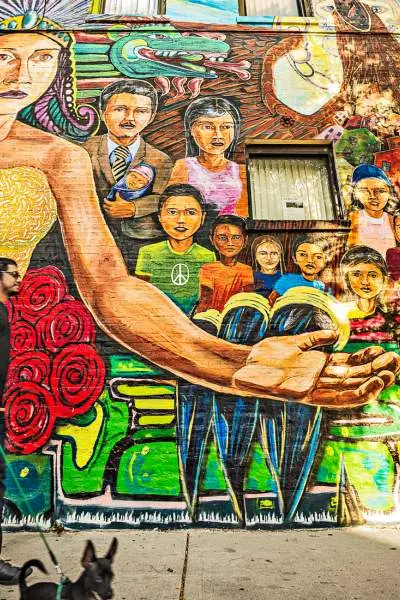Explore Global Chicago
A microcosm of America’s melting pot, Chicago’s ethnic neighborhoods provide numerous continents’ worth of culinary and cultural exploration, no passport required.
Aug 23, 2017 • Chicago

Chicago contains 77 community areas containing more than 100 diverse neighborhoods with more than 5,195 restaurants.
Those stats can be overwhelming to any visitor wanting to take a cultural and culinary tour of the city, so this guide breaks down the neighborhoods in which you can discover the most authentic tastes of food and experiences from countries around the world. Dig in!
Mexico
The aroma of meat and maize wafts over 18th Street in Pilsen (on the city’s southwest side), and bright murals splashed across the neighborhood tell the story of the predominantly Mexican community. Originally settled (and named Pilsen) by Czech and other Eastern European immigrants in the late 19th century, the affordable neighborhood gradually adopted a Latino base. At the National Museum of Mexican Art, the large collection includes thought-provoking pieces (an oil painting of a woman vacuuming the Mexican border; a lawn mower souped-up like a lowrider). When hunger strikes, an abundance of casual taquerias beckon.

At Carnitas Uruapan, a value meal includes a half-pound of tender carnitas (slow-cooked pork), a stack of corn tortillas and a pile of chicharróns (fried pork rinds). The Taqueria El Milagro serves smoky steak tacos in tortillas from the eponymous factory nearby. And at Xurro Churro Factory, vanilla ice cream topped with fudge sauce and a churro (a fried pastry) makes for a Hispanic-inspired dessert.

The Middle East
In Albany Park, Kedzie Avenue acts as a veritable kabob corridor. Between Wilson and Lawrence cross streets, visitors discover Lebanese, Persian and Mediterranean spots (along with a few taquerias and pho joints). But no other place in Chicago holds more Middle Eastern eats. At Kabobi Grill, crowds order tender filet mignon and chicken kabobs along with ultracreamy hummus and baba ghanoush (eggplant dip) served with warm pita. A block north, Jaafer Sweets serves honeyed pistachio treats and chocolate baklava with walnuts.
India and Pakistan
On Devon Avenue, you’re more likely to find a stunning sari for sale than a sundress, and the grocery store carries the name Patel Brothers. It’s been that way since the 1970s, when a handful of Indian merchants set up shop in this affordable part of West Ridge, once dominated by a Jewish community. Today, Chicago’s unassuming Little India blankets a 10-block region packed with spice shops, buffet restaurants, kabob and curry houses, beauty salons, sweets shops and more. Udupi Palace, a vegetarian restaurant known for its southern Indian cuisine, serves palak dosa—a light and crispy spinach-filled crepe—that, here, measures nearly 2 feet in diameter. Meat takes center stage at Khan BBQ, a casual Pakistani tandoori grill. Surrounded by pink walls, grillmasters barbecue chicken boti—boneless chicken breast marinated in yogurt spiced with cumin and coriander.

Vietnam
You’ve likely heard of Chinatown, but what about Asia on Argyle? You know you’ve reached this north-side community in the Uptown neighborhood by the pagoda-style architecture around the Argyle Red Line L stop.
Led by business owners looking to create a North Side Chinatown, residents from China and Southeast Asia moved here in the 1970s. Following the fall of Saigon in 1975, a wave of Vietnamese families moved in, bringing with them Southeast Asian flavors. The bustling Tank Noodle serves pho, a beefy noodle soup punctuated by cinnamon, cloves and cardamom, and served with bean sprouts, basil and jalapeños on the side to add DIY style. Across the street, Ba Le mixes refreshing bubble tea-fruit smoothies (the pineapple and mango are both winners). And locals know Nhu Lan, located about 2 miles west, as the best place for banh mi sandwiches. Go for the No. 10: lemongrass tofu topped with cilantro and carrots on a baguette.
Sweden
In 1900, one of every 10 Swedish-Americans lived in Andersonville. While it’s no longer the Swedish capital of America, the neighborhood retains an artsy Northern European flair. The enlightening Swedish American Museum tells the story of the Scandinavian community’s move to the city’s north side following the Great Chicago Fire of 1871 (Swedes could still build their signature wooden homes here, because it was outside city limits at the time). Svea, a comfy diner bursting with Scandinavian blue-and-yellow pride, serves comfort food like saucy Swedish meatballs and crepelike Swedish pancakes.

Poland
Once upon a time, Chicago was home to the largest Polish population of any city outside of Warsaw. Early immigrants drawn to work in the steel and railroad industries lived in an area known as Chicago’s Polish Downtown (near Wicker Park). The Polish Museum of America here exhibits art and historic artifacts, including a wall of stained glass from the 1939 New York World’s Fair.

But visitors can find Polish patches all over the city. In the Avondale neighborhood, families gather for kielbasa and zucchini pancakes with goat cheese at Staropolska, an old-world restaurant warmed by a fireplace.
Share your Moments
#EnjoyIllinois




